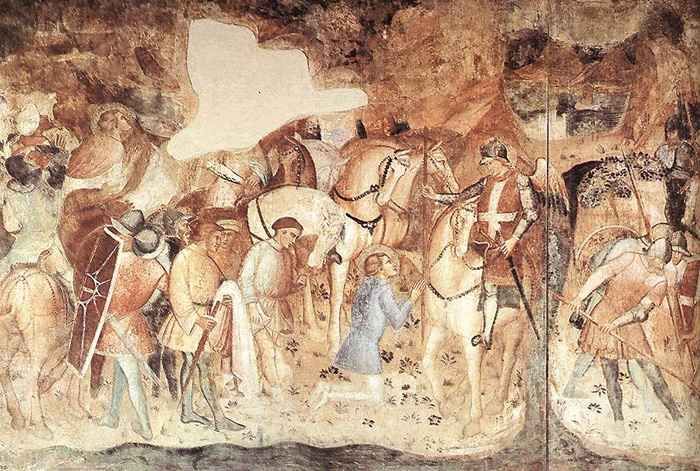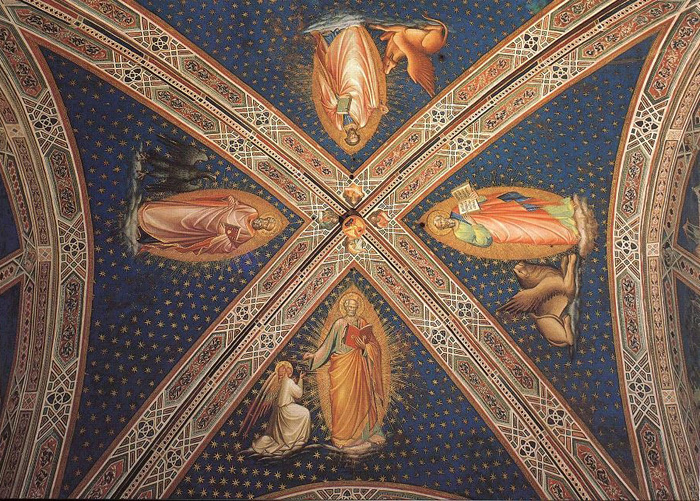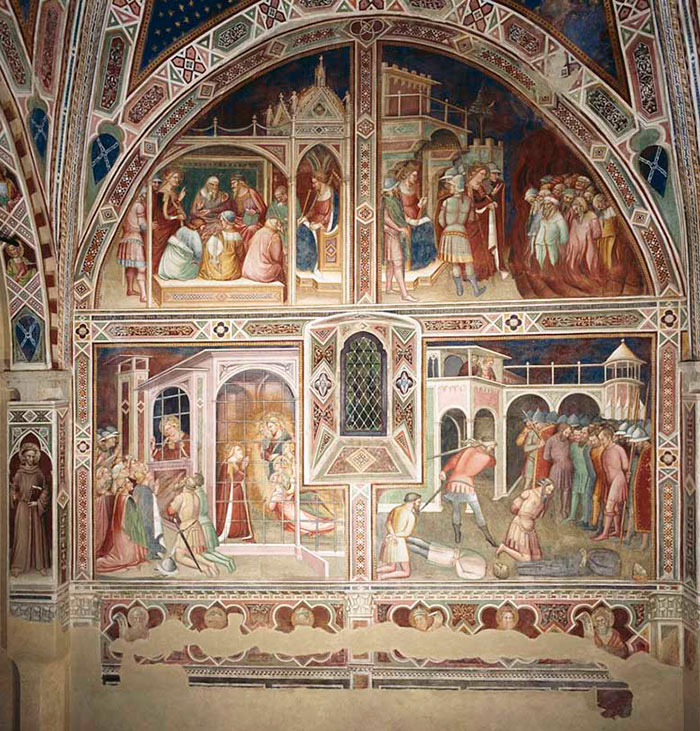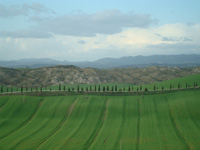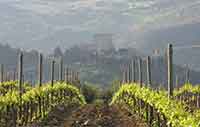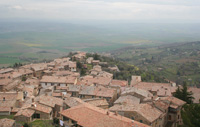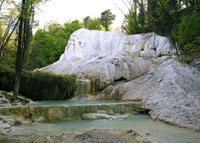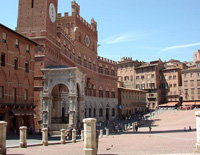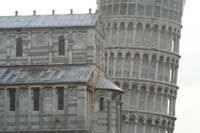| |
|
| Spinello Aretino (c. 1350 – c. 1410) was an Italian painter, the son of a Florentine named Luca, who had taken refuge in Arezzo in 1310 when exiled with the rest of the Ghibelline party.
Spinello was a pupil of Jacopo del Casentino, a follower of Giotto, and his own style was a sort of link between the school of Giotto and that of Siena. In the early part of his life he worked in Florence as an assistant to his master Jacopo while painting frescoes in the church of the Carmine and in Santa Maria Novella. Between 1360 and 1384 he was occupied in painting many frescoes in and near Arezzo, almost all of which have now perished.
After the sack of Arezzo in 1384 Spinello returned to Florence, and in 1387-1388 with some assistants covered the walls and vault of the sacristy of San Miniato of Florence with a series of frescoes, the chief of which represent scenes from the life of Saint Benedict. These still exist, though in a sadly restored condition; they are very Giotto-like in composition, but have some of the Siena decorative brilliance of color.
In 1391-1392 Spinello was painting six frescoes, which still remain on the south wall of the Pisan Campo Santo, representing miracles of St. Potitus and St. Ephesus. For these he received 270 gold forms. In a series of frescoes Spinello Aretino depicted the story of St Ephisius and St Potitus, two saints from Sardegna, who were buried in the Pisa cathedral.Among his later works the chief are the very fine series of frescoes painted in 1407-1408 on the walls and vault of a chapel in the municipal buildings of Siena; these also have suffered much from repainting, but still are the finest of Spinello's existing frescoes. Sixteen of these represent the war of Frederick Barbarossa against the republic of Venice.
Spinello's frescoes are all strong and highly decorative works, drawn with much spirit, and are very superior in style to his panel pictures, many of which appear to be mere bottega productions. The academy of Florence possesses a panel of the Madonna and Saints, which is chiefly interesting for its signature Hoc opus pinxit Spinellus Luce Aritio D.I.A. (1391). The easel pictures which are to be found in the various galleries of Europe give little or no notion of Spinello's power as a painter.
After Spinello completed an image of the devil, the subject visited him in a dream and complained about the representation, citing it as the worst such that he'd seen. |
|
|
|
| |
|
Works
* Annunciazione all'esterno della Chiesa della Santissima Annunziata, Arezzo
* Polittico con la Madonna col Bambino e santi, Museo Diocesano di Arezzo
* Storie di san Benedetto, 1387-1388, sagrestia di San Miniato al Monte, Firenze
* Storie di Alessandro III, Palazzo comunale, Siena
* Matrimonio mistico di santa Caterina d'Alessandria tra santi, basilica di Santa Trinita, Firenze
* Santo Stefano, Galleria dell'Accademia, Firenze
* Trittico della Madonna in trono e santi, Galleria dell'Accademia, Firenze
|
Stories from the Legend of St Benedict, 1387, Spinello Aretino, Firenze, San Miniato al Monte
|
|
|
Spinello Aretino, Stories from the Legend of St Benedict, 1387, Firenze, San Miniato al Monte, fresco.
This fresco covers the wall of the Sacresty in S. Miniato al Monte
|
The Four Evangelists, 1387, San Miniato al Monte, Firenze
|
|
The Four Evangelists, 1387, Spinello Aretino, Firenze, San Miniato al Monte, Fresco. The ceiling fresco of the Sacresty in S. Miniato al Monte represents the four Evangelists
|
Scenes from the Life of Alexander III, 1407
|
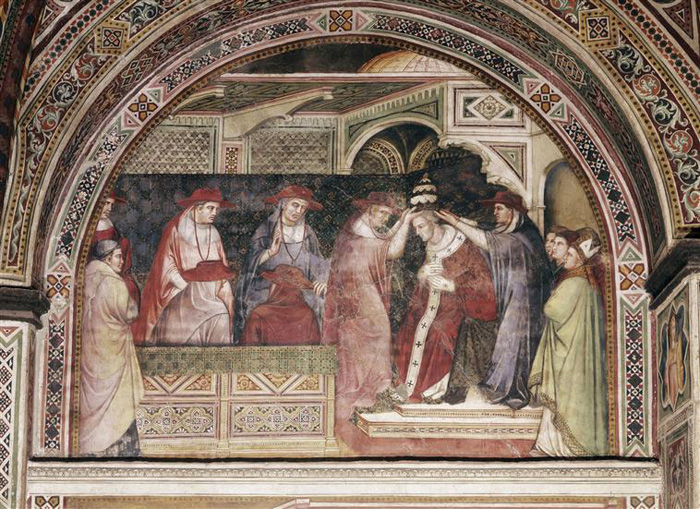 |
Spinello Aretino, Storie di Alessandro III, Incoronazione di papa Alessandro III, Palazzo Publicco, Siena
|
He was the most prolific muralist of his time and undertook large fresco cycles all over Tuscany. The last of these was devoted to the Sienese pope Alexander III in the Palazzo Pubblico in Siena (1408–10); he was the first non-Sienese painter to work in the building.
The frescoes were commissioned by the Priors from Spinello Aretino for the Sala dei Priori, Palazzo Pubblico, Siena.
Next to the Sala del Concistoro is the Sala di Balia, also known as Sala dei Priori. This room is adorned with frescoes by Spinello Aretino illustrating the Life of Pope Alexander III dei Bandinelli.
In 1407 the Priors of the Palazzo Pubblico commissioned Spinello, assisted perhaps by his son, Parri Spinelli to paint the walls of their meeting room, the Sala dei Priori. The subject matter of the two-tiered frescoes, which cover all four walls of the room, concerns the Sienese Pope Alexander III Bandinelli (r. 1159-81). Supposedly this subject was chosen as the result of a visit of Pope Gregory XII to Siena, the frescoes being intended to remind the current incumbent of a Sienese citizen who had been pope and who had even brought the fearsome Barbarossa to his knees. [1]
|
|
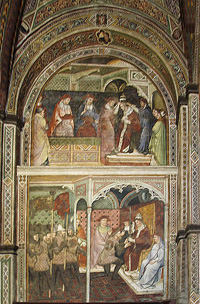
|
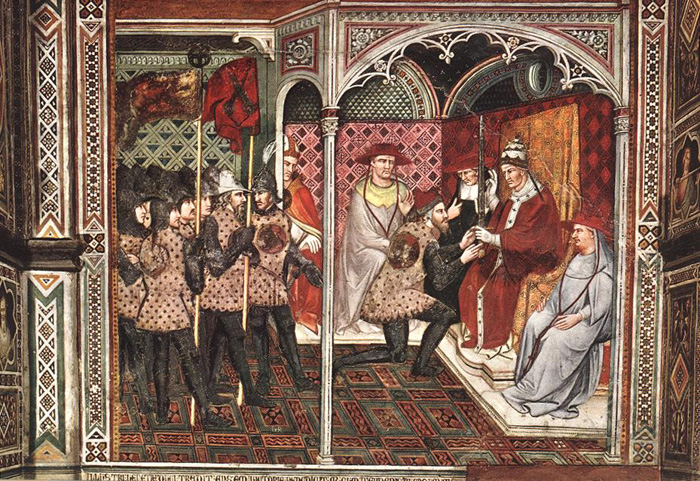 |
Spinello Aretino, Scenes from the Life of Alexander III, Pope Alexander III Receives an Ambassador, Palazzo Pubblico, Siena
|
La Sala di Balia
|
|
|
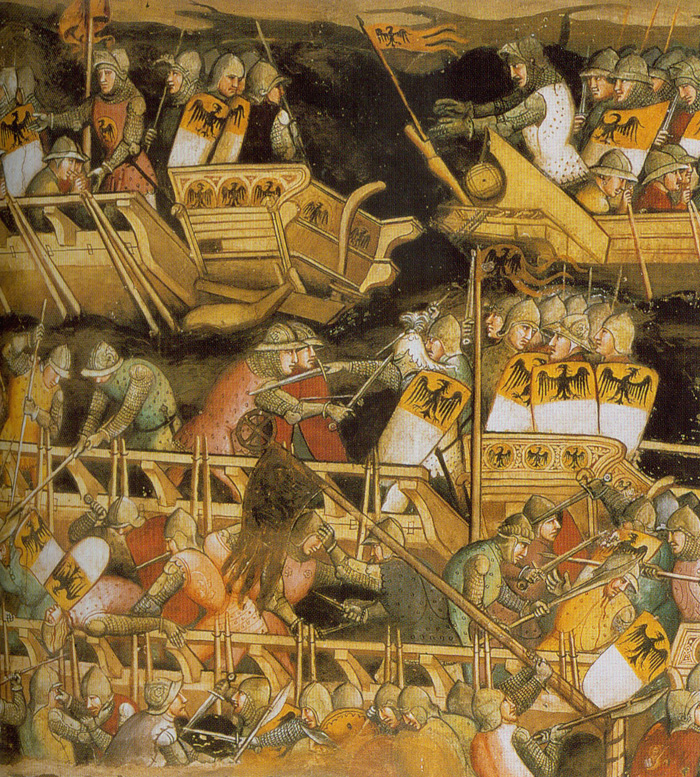 |
| |
|
|
|
Marriage of Saint Catherine of Alexandria by Spinello Aretino
|
|
Spinello Aretino, Marriage of Saint Catherine of Alexandria by Spinello Aretino, 1390, fresco, Santa Trinita, Firenze
|
Santa Trinita in Florence
Santa Trinità is a Florentine church of the Vallumbrosan Order of monks founded in 1092 by a Florentine nobleman. The church is famous for its Sassetti Chapel, containing notable frescoes by Domenico Ghirlandaio that represent true masterpieces of 15th century art.
The church has approximately 20 chapels, each of which contain a significant amount of artwork. The most famous are the Sassetti and the Bartolini-Salimbeni chapels which contain frescoes by Domenico Ghirlandaio and the Quattrocento artist Lorenzo Monaco, respectively. Francesco Sassetti had been a manager of the Medici bank. The Ghirlandaio frescoes use as backgrounds the then contemporary Florentine city views.
Beyond Bernardo Buontalenti's late-16th-century facade lies a dark church, rebuilt in the 14th century but founded by the Vallombrosans before 1177. The third chapel on the right has what remains of the detached frescoes by Spinello Aretino, which were found under Lorenzo Monaco's excellent 1422 frescoes covering the next chapel down.
|
The Oratory of Santa Caterina in Bagno a Ripoli
|
|
|
|
Spinello Aretino, Bagno a Ripoli
|
The oratory was built in 1354 by the Alberti family and decorated with a fresco cycle depicting the Life of Saint Catherine of Alexandria.
Built in rows of limestone, the oratory has a single nave divided into two bays by a cross vault and a small rectangular apse.
The interior contains beautiful frescoes that tell the story of the life of the Princess and martyr, St. Catherine of Alexandria, or of the Wheel, because of the way she was martyred. The frescoes were started around 1360 by the Maestro of Barberino and Pietro Nelli, and were later completed at the wish of Benedetto Alberti by one of the major exponents of Tuscan fourteenth-century painting, Spinello Aretino (1390-95).
|
The remarkable pictorial cycle begins in the apse with scenes of the martyrdom of the Saint. Two artists, as recently distinguished by experts, worked on this section. They were the so-called Maestro di Barberino, anonymous painter in the style of Orcagna, and Pietro Nelli (a student of Bernardo Daddi), who was able to mitigate the angularity of the first master by means of an elegant plasticity.
The lunette depicting the Annunciation on the back wall, the depictions of St. Benedict and the Holy Deacon, the decoration of the spandrels and sottarco of the chapel and the three scenes in the apse have been attributed to Barberino. After these works nothing further was added for 30 years, until Benedetto di Nerozzo degli Alberti commissioned paintings depicting the stories of the burial of the Saint in the Oratory in his will. It is thanks to Benedetto's wish the unfinished work on the triumphal arch was completed by Spinello Aretino, a well-known late-14th century painter from Arezzo. He finished the decorations on the arch and continued the narration of the life of the Saint through eight episodes, illustrated in the lunettes and lower panels. In the rib vaults he painted the Four Evangelists with their corresponding symbols while on the arch he painted the Apostles with the Agnus Dei. Along the base rest busts of the Prophets.[2]
Address: Via del Carota, 50012 Loc. Ponte a Ema, Bagno a Ripoli.
|
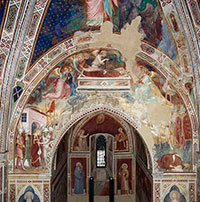 |
|
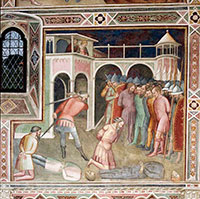 |
|
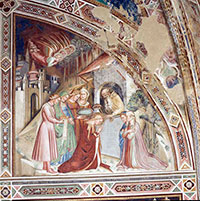 |
|

[1] In an attractive location at the gates of Chianti, the Oratory of Saint Catherine the Wheel in Rimezzano, from the homonymous trench that runs nearby, was built in 1354 at the bequest of Alberto degli Alberti by his sons Giovanni and Jacopo together with their cousins Bernardo and Benedetto, sons of Nerozzo. Very soon, however, with the exile of the Alberti family and their relatives, and the confiscation of their possessions, began for the Oratory a period of slow abandonment, which stretched for centuries despite the illustrious owners. The day after Italian Unification, the mayor of Bagno a Ripoli asked the Prefect of Florence that the chapel might be given to the Commune to provide for the conservaion of the pictures. The appeal was ignored, such that in 1892 the property passed from the celebrated architect to a lesser known Roman salami specialist. Again in 1925 the daily “La Nazione” denounced the ‘disastrous conditions’ of the frescoes and the persistent use of the chapel as a henhouse and a hay store. Years passed without any change then the Oratory, with the handwritten will of the engineer Giuseppe Pedriali of 30th April 1930, was brought within the holdings of the Antella factory that the Province of Forlì, beneficiary, welcomed with the law of 7th September 1948. Loyal to his political ideals, Pedrali had wanted that his substantial holdings in the area went, on his death, to Mussolini’s homeland.
[2] Source: Comune di Bagno a Ripoli - Itinerary 2: Sacred Streets - the Bagno a Ripoli, Villamagna and Antella Parishes |www.comune.bagno-a-ripoli.fi.it |
|
|
| |
|
 |
www.polomuseale.firenze.it | Santo Stefano sorregge lo stendardo con lo stemma dell'Arte della lana, Crocifissione di Cristo con la Madonna e San Giovanni Evangelista nella cuspide, Galleria dell'Accademia, Firenze
www.polomuseale.firenze.it | Madonna con Bambino e Santi, Galleria dell'Accademia, Firenze
L'Oratorio di Santa Caterina all'Antella e i suoi pittori, a cura di Angelo Tartuferi. Published 2009 by Mandragora in Firenze.
Catalog of an exhibition held at the Oratorio di Santa Caterina, Bagno a Ripoli, Italy, Sept. 19-Dec. 31, 2009.
Bibliografia
Stefan Weppelman, Spinello Aretino e la pittura del Trecento in Toscana, Firenze, 2011. ISBN 9788859608776
Giovanni Matteo Guidetti, La Cappella del Cardinale del Portogallo a San Miniato al Monte, in AA.VV., Cappelle del Rinascimento a Firenze, Editrice Giusti, Firenze 1998.
Jane Turner (a cura di), The Dictionary of Art. 29, pp. 403-407. New York, Grove, 1996. ISBN 1884446000
Art in Tuscany | Art in Tuscany | Giorgio Vasari | Lives of the Most Excellent Painters, Sculptors, and Architects
Lives of the Most Eminent Painters Sculptors and Architects, Giorgio Vasari | download pdf
|
|

Oratorio di S. Caterina degli Alberti - Bagno a Ripoli (Fi) XIV sec.
The frescoed cycles portray scenes from the life of Saint Catherine of Alexandria.
|
|
This article incorporates material from the Wikipedia article Spinello Aretino published under the GNU Free Documentation License.
Wikimedia Commons contiene file multimediali su Spinello Aretino, Matrimonio mistico di santa Caterina d'Alessandria tra santi, and Sagrestia di San Miniato al Monte.
|

Holiday accomodation in Tuscany | Podere Santa Pia | Artist and writer's residency
|
| |
|
|
|
|
|
Podere Santa Pia |
|
|
|
Val d'Orcia |
|
|
|
|
|
| Monte Cucco wine region |
|
Cipresses between Montalcino and Pienza |
|
Montalcino |
| |
|
|
|
|
|
|
|
|
|
Bagni San Filippo |
|
Siena, Piazza del Campo
and Palazzo Publicco
|
|
Pisa |
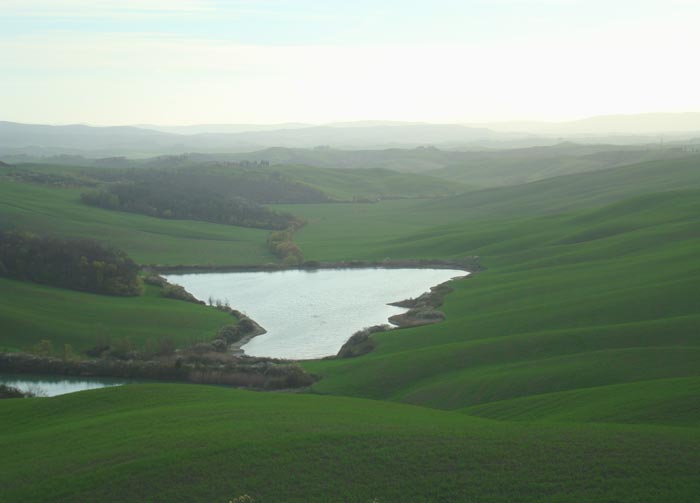
|
| Terre di Siena |
| |
|
|
|
|
| |
|
|
|
|
|
|
![]()
![]()
![]()
![]()

